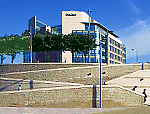|
An extensive industrial and commercial estate in the far north of Acton, between the Western Avenue and the Grand Union Canal.
Formerly the village of Twyford, the present name derives from the Royal Agricultural Society exhibitions held here from 1903
to 1905. Munitions factories were built on the site during the First World War, and it developed as an important industrial
estate after hostilities ended. Employers included HJ Heinz and Waterlows printers, and there were stadiums for greyhound
racing and football. During the 1970s and 80s several of Park Royal’s factories closed and parts of the area became
derelict. The Park Royal Partnership plans to address the decline with a massive increase in the size of the Park Royal estate,
bringing 25,000 new jobs by 2012, and a related improvement in the quality of the built and landscaped environment. Contrary
to the general trend towards exclusively high-tech business parks, manufacturing industry will continue to play a part. A
new Central Line stop is proposed, making Park Royal an underground interchange. Drinks conglomerate Diageo has its headquarters
in Park Royal (see picture below). The neighbouring Guinness brewery, built by Sir Giles Scott in 1934, is due to close soon,
owing to Diageo’s excess production capacity. Park Royal is also known to the public for its Asda superstore and the
Royale leisure park, which includes a nine-screen multiplex and a 36-lane bowling alley. The complex lies on the opposite
side of Western Avenue from the main estate.
 |

